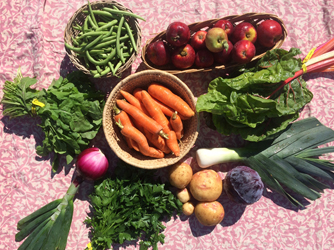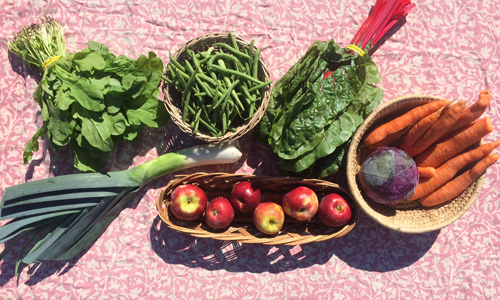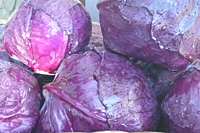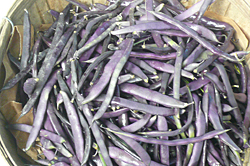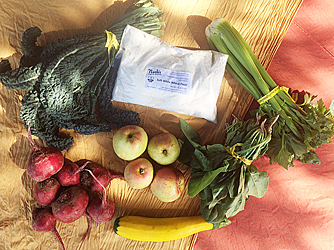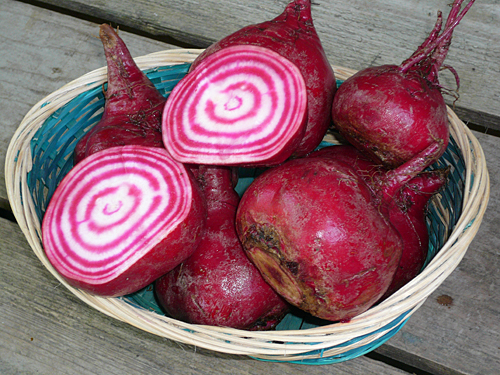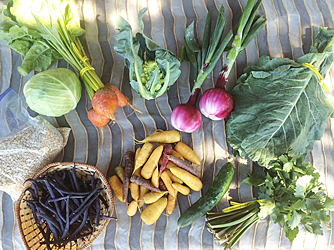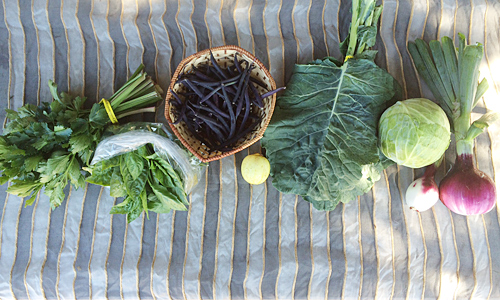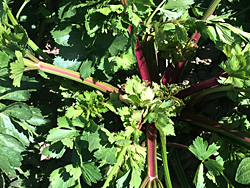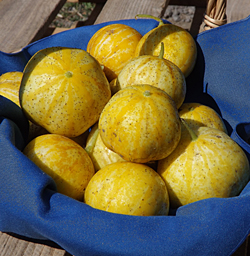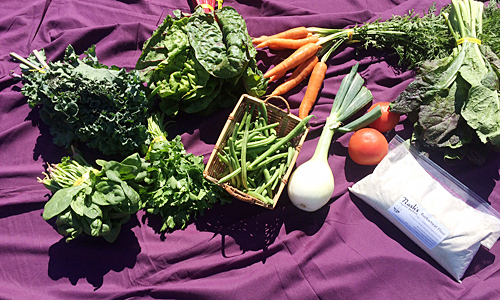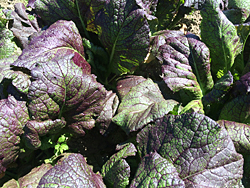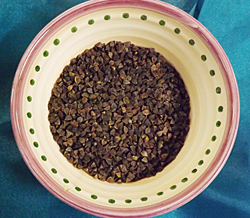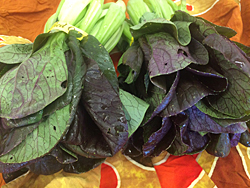In the Standard Box:
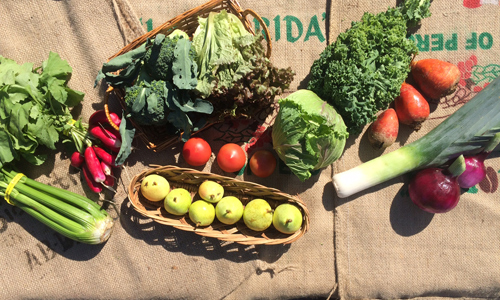
Pears 2 lb
Golden Beets, Bulk 2 lb
Green Kale 1 bu
Tomatoes, Slicers 1 lb
Celery 1 hd
Savoy Cabbage 1 hd
Broccoli 1.25 lb
Leek
Radishes 1 bu
Red Onions 2
Red Leaf Lettuce* 1 hd
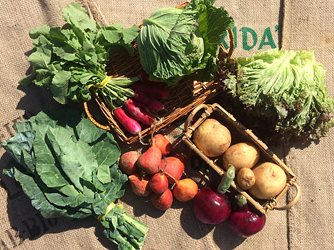
In the Small Box:
Collards 1 bu
Golden Beets, Bulk 2 lb
Potatoes 2.5 lbs
Savoy Cabbage 1 hd
Red Onions 2
Radishes 1 bu
Red Leaf Lettuce* 1 hd
Nash’s Celery
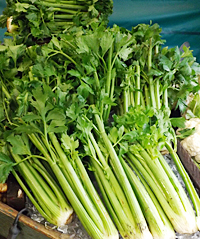
Real celery, not its watered-down conventional cousin, is a SUPERFOOD! It has taste, substance and crunch. One cup of chopped celery has 33% of your daily vitamin K needs. It is an anti- oxidant and phytonutrient powerhouse. It is highly anti-inflammatory. It’s good for your digestive and cardiovascular systems. It helps fight cancer. And all parts of celery can be eaten—stalks, roots, leaves, and seeds.
Celery stalks are best eaten raw to get the full health benefits. If you must cook them, try steaming them lightly, rather than boiling them. They’re great in a stir-fry.
For a unique snack, spread 2 slices of artisan, whole-grain toasted bread with organic almond butter. Top with diagonally-sliced celery stalks and a finely-chopped date. Season with a flaky sea salt and drizzle with olive oil just before serving.
About Savoy Cabbage
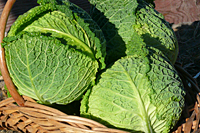
Savoy cabbage is the prettiest cabbage around! The beautiful crinkly leaves are tender and mild enough to be added raw into any salad. It’s high in vitamin K, vitamin C and fiber. It’s also a very good source of manganese, folate, vitamin B6, potassium, and omega-3 fatty acids.
You can use your Savoy in many ways. Its natural sweetness makes it a wonderful foil for rich and salty foods like duck confit, bacon or sausages. It is equally delicious as a bed for mild white fish or seafood. It can be cooked or used raw. It can be braised, roasted or boiled, and it’s very easy to saute it in butter, olive oil or bacon fat with a little garlic, salt and pepper for a tasty side dish.
For a quick stir-fry, thinly slice your Savoy and lightly steam for 3-4 minutes until tender. Drain well. Heat 1 Tbsp. olive oil in a wok or skillet, and toss in 2 cloves sliced garlic and 1 tsp. fennel or caraway seeds. Cook for 1 minute until beginning to turn golden. Add the cabbage and stir-fry over the high heat for 3-4 minutes. Season with a little salt and serve.
Roasted Savoy Cabbage
1/4-1/3 cup olive oil
Salt
Freshly-ground black pepper
Lemon juice to taste
Dash cayenne or chili flakes (optional)
Preheat oven to 400°F and grease a rimmed baking sheet. Cut the cabbage into quarters vertically and carve out the core. Cut each quarter in two lengthwise, and thinly slice.
Place the cabbage in a large bowl, drizzle with olive oil, sprinkle with salt, and toss to coat evenly. Insert in the oven and bake for 15 minutes, stirring halfway through, until cooked thoroughly and golden brown in places. Be very careful not to burn it.
Remove from oven, sprinkle with black pepper, dress with a touch of lemon juice, and serve. Like a little kick? Sprinkle with a tiny bit of cayenne, or chili flakes.
We thank www.chocolateandzucchini.com.
Taste of Autumn–Pears
The skin of the pear contains about ½ of the entire dietary fiber content, and about 3-4 times more of the phytonutrient content than the flesh, which provides anti-inflammatory and anti-oxidant protective benefits.
Pears contain a specific group of phytochemicals, flavanols and anthocyanins (in red skinned pears) that have been shown to help improve insulin sensitivity, and decrease the risk of Type II diabetes.
Pears are an excellent source of fiber, vitamin C, vitamin K, and the mineral copper, critical for building strong tissues, maintaining blood volume, and producing energy in your cells.
Pears with Blue Cheese and Prosciutto
This recipe combines sweet and savory, is super easy to prepare, and is a definite crowd-pleaser.
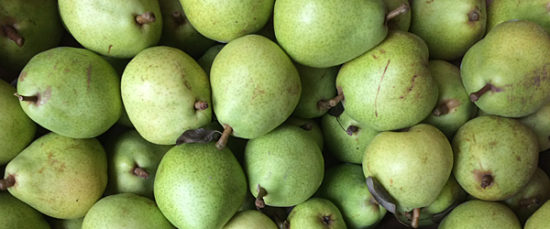
2 pears (such as Bosc or Bartlett), cut into 8 wedges
2 tsp. fresh lemon juice
1 cup arugula
3 oz. blue cheese, cut or crumbled into pieces
6 oz. thinly sliced prosciutto, cut in half lengthwise
In a large bowl, toss the pears and lemon juice. Layer a slice of pear, an arugula leaf, and a few pieces of cheese on a piece of prosciutto and roll up. Secure with a toothpick, arrange on a platter, and enjoy this great combination of flavors!
Recipe from www.realsimple.com
Collards with a kick

Heat 3 Tbsp. butter in a 6-qt. pot over medium heat. Add 1/8 tsp. each of cardamom and fenugreek seed and cook, stirring often, until fragrant, 1–2 minutes. Increase heat to medium-high and add 1/8 cup oil; add 1/2 of an onion (minced) and cook, stirring often, until browned, 10 minutes. Add 2 cloves minced garlic, 1 seeded and minced chili, and 1/2-inch grated fresh ginger and cook, stirring often, until soft and fragrant, 3 minutes. Add 1 bunch collards, stemmed and cut in thin strips, 1 cup water, and salt and pepper to taste. Cover and bring to a boil. Reduce heat to low and cook, stirring occasionally, until collards are tender, 50–55 minutes. Stir in a dash white wine vinegar and serve hot.

